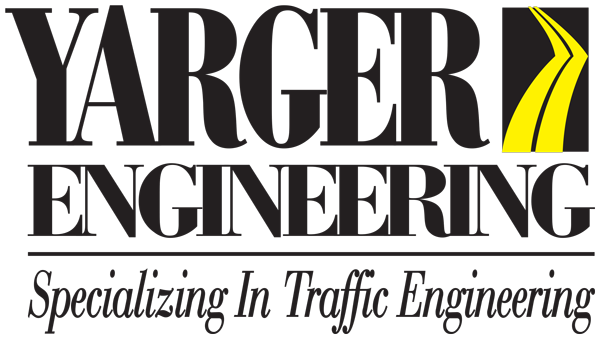Frequently Asked Questions - Yarger Engineering, Inc. 317-475-1100 Email Us
Frequently Asked Questions
There a many question about traffic people often ask. The following is a list of questions linked to answers below. If you don't see your question, please email us so we can add your question and the answer to our page.
- How much does a traffic study cost?
- Why is there so much traffic congestion?
- What is the Manual on Uniform Traffic Control Devices?
- Why are the speed limits so high or low?
- Does speed kill?
- How can we stop people from driving too fast in our neighborhood?
- Will more STOP signs slow traffic on a street?
- Are roundabouts safe?
- Will installing a signal make an intersection safer?
- When should a traffic signal be installed?
- Why aren’t the signals synchronized so I can drive without stopping?
- Why are there turn arrows at some signals and not at others?
- Why do I have to wait so long for a green light on a side street?
- Why is the WALK light so short, and the flashing DON'T WALK light so long?
- Do I really need to push the pedestrian button?
- Is driving while talking on the phone with a hands free headset safe?
- How often should traffic counts be taken?
How much does a traffic study cost?
 It depends on the scope of the study, and there is a wide range. Traffic hose counts start at $400 each. Intersection turning movement counts run about $400 for AM and PM peaks, and $1,000 for 12 hour counts. Roundabouts and complex signaized intersections will cost more. The number of intersections in a full traffic impact study is typically the main driver of costs at about $2,500 - $3,500 per intersection. A small traffic impact study will have three intersections, while large ones can have ten or more intersections. Yarger Engineering, Inc. also reviews studies done by others and that typically runs about 10% of the original study cost. In some cases, large governmental traffic studies can run into the hundreds of thousands or even millions of dollars. See our traffic study article for more information.
It depends on the scope of the study, and there is a wide range. Traffic hose counts start at $400 each. Intersection turning movement counts run about $400 for AM and PM peaks, and $1,000 for 12 hour counts. Roundabouts and complex signaized intersections will cost more. The number of intersections in a full traffic impact study is typically the main driver of costs at about $2,500 - $3,500 per intersection. A small traffic impact study will have three intersections, while large ones can have ten or more intersections. Yarger Engineering, Inc. also reviews studies done by others and that typically runs about 10% of the original study cost. In some cases, large governmental traffic studies can run into the hundreds of thousands or even millions of dollars. See our traffic study article for more information.
Why is there so much traffic congestion?
 Money. No one wants to pay for the improvements unless they are forced to or the congestion becomes unbearable. There are far more problems than there is funding to address them. Congress is reluctant to raise the gas tax which is still at the same amount per gallon as it was in 1993! Of course, inflation has driven up the cost of road improvements and cars get better mileage than they did in 1993, so the gap between what is needed and what is coming in on a per mile driven basis is widening.
Money. No one wants to pay for the improvements unless they are forced to or the congestion becomes unbearable. There are far more problems than there is funding to address them. Congress is reluctant to raise the gas tax which is still at the same amount per gallon as it was in 1993! Of course, inflation has driven up the cost of road improvements and cars get better mileage than they did in 1993, so the gap between what is needed and what is coming in on a per mile driven basis is widening.
Real estate developers are in the business to make money, not spend it to benefit others. They want the least costly road solutions that meet the governmental requirements. Some congestion is acceptable to the developers as long as their clients’ customers don’t avoid the area and shop at other businesses. If the government requires lower levels of congestion, development may get priced out of the feasibility range and seek to develop in other locations where there is more available road capacity, but that can increase overall demand on the road network because people have to drive farther.
There are other reasons such as limited right-of-way (land), but that gets back to money to buy more right-of-way. Right-of-way is often limited by surrounding development which drives up the cost to the point of being unfeasible, like in a downtown district where the buildings are just feet from the curbs. There are other constraints such as cemeteries, historic locations, or natural constraints like rivers.
Money also becomes the issue with minor fixes such as retiming traffic signals and fixing pothole. These require funds to pay the people to do it, and many times it comes down to choosing between DOT/DPW funds against schools and law enforcement because raising taxes is politically unfeasible.
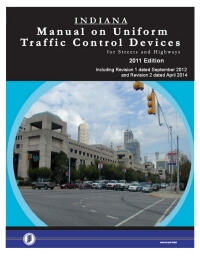
What is the Manual on Uniform Traffic Control Devices?
The Manual on Uniform Traffic Control Devises (MUTCD) is the “building code” of traffic engineering. It contains information on when, where, and how to install traffic control devices (signs, pavement markings, signals, etc.). One of the main points of having an MUTCD is that the signs, markings, etc. are the same in all states. It is based off a federal version, but most states adopt their own with slight changes. For example, Indiana has a WATCH FOR ICE ON BRIDGE sign that isn’t needed in Hawaii. In Indiana, following the MUTCD is required for all public roads. The MUTCD allows flexibility in some situations, but also contains minimum requirements, such as traffic signal warrants and sign sizes.
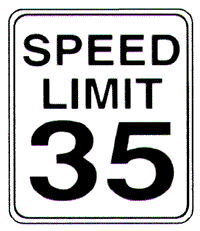
Why are the speed limits so high or low?
There are statutory speed limits that would require a speed study to change, but the design of the road and road side often don’t allow higher speed limits even if everyone is driving higher that the posted limit. The requirements for the speed limits and studies are in the MUTCD Section 2B.13 (page 56).
Drivers often don’t realize the hazards that lurk off the side of the road, like utility poles and trees, and think that the pavement geometry is the main constraint on speeds. They often over estimate their emergency driving ability, believing that their average response is good but not thinking about their own less than average response. It has also been said that about 80% of drivers believe they are above average drivers!
Speed limits may also be set lower to benefit those not in cars, such as pedestrians. Setting speed limits artificially lower than normal usually just mean more people are ignoring the speed limits as opposed to actually lowering the speeds on the street. Traffic calming measures need to be implemented in addition to lowering the speed limits to change driver behavior. See our neighborhood traffic calming article for more information.
Does speed kill?
Astronauts don’t die because they are going 25,000 MPH in space. Technically, what kills is force, which is a function of acceleration, or more typically in vehicle crashes, deceleration. Softer items in the road and vehicle environment like crash barriers and airbags change the deceleration equation by increasing the time of the crash. That said, deceleration is a function of the initial and final speeds during the crash.
The faster the vehicle speed the more distance it takes to avoid a crash and that distance may not be available at higher speeds.
In the case of vehicle - pedestrian crashes the speed that the vehicle hits the pedestrian is critically important, as can be seen from the following table showing speed versus mortality. Note that hitting a pedestrian at 40 MPH is 17 times more likely to kill the pedestrian than hitting them at 20 MPH, not double.
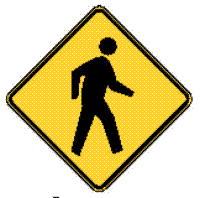
Vehicle Speed |
Odds of Pedestrian Death |
0 MPH |
0% |
20 MPH |
5% |
30 MPH |
45% |
40 MPH |
85% |
[Source: Killing Speed and Saving Lives, UK Dept. of Transportation, London, England.]
How can we stop people from driving too fast in our neighborhood?
There are some methods that work and numerous ones that don’t. The most common effective method is speed humps placed every 250 to 400 feet, but they come with drawbacks. See our neighborhood traffic calming article for more information.

Will more STOP signs slow traffic on a street?
Only at the STOP signs. Motorists will speed up between the stop signs to make up for lost time. The MUTCD 2B.04 (page 50, paragraph 5) says that YIELD or STOP should not be used for speed control. See our neighborhood traffic calming article for better ways to slow traffic on a street.
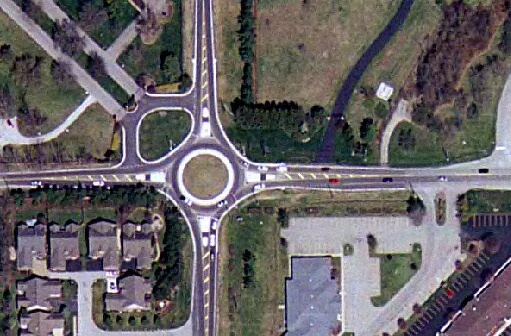
Are roundabouts safe?
Yes, they are much safer than traffic signals, and more efficient than all-way stops. Unfortunately they are expensive. INDOT pays around $1,000,000 per single lane roundabout to retrofit a signalized intersection, and about $1,600,000 for a multi-lane roundabout. A signal without any turn lanes or sidewalks runs about $75,000 to $150,000. All-way stops, well those are dirt cheap at about $200 per sign. See our roundabout article for more information.
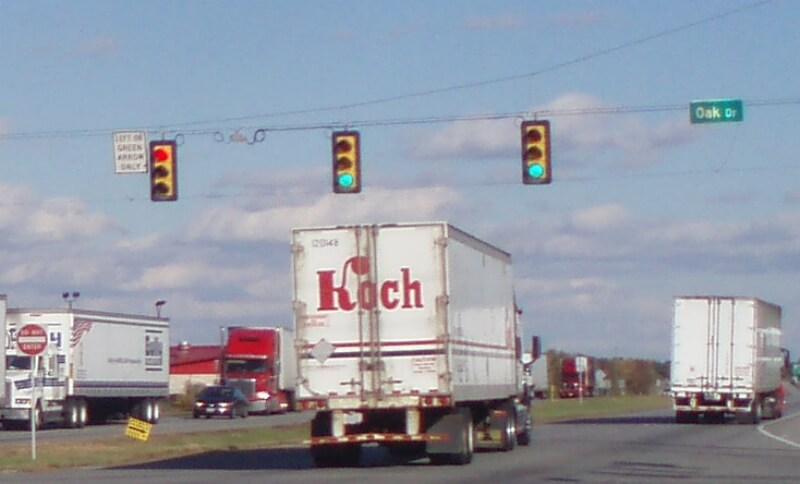
Will installing a signal make an intersection safer?
Not necessarily. Most high crash locations are at signals. The signal redefines who has the right-of-way, but drivers don’t always react correctly to the signal. Some run the red and cause right angle crashes, sometimes called T-bone crashes. This is similar to someone running a stop sign. The bigger problem is rear-end crashes which increase at signals. A better option for making an intersection safer usually is a roundabout. See our traffic signal article for more information.
When should a traffic signal be installed?
Traffic signals allot time for various movements to be in an intersection. By design they do not allow other movements to enter the intersection during those times, regardless of whether it would safe and efficient or not. This introduces needless delay, so signals should not be installed unless they are going to improve a situation. Most signals that are installed improve conditions over a two-way or all-way stop during peak conditions, 2 – 8 hours a day; but are not needed and inefficient during the non-peak conditions, 16 – 22 hours per day. The MUTCD Section 4C (page 440) has warrants that are the minimum criteria for when a signal is allowed. Meeting the warrants doesn’t require that a signal be installed, but if the warrants are not met, Indiana state law IC 9-21-3-3 requires that the signal be removed. The warrants are based on several criteria, but most of them are related to traffic volumes, pedestrian volumes and safety. In many cases where a signal is warranted, a roundabout may be a better solution to the traffic problem. See our traffic signal article for more information.
Why aren’t the signals synchronized so I can drive without stopping?
Signal synchronization (progression) in most real world situations is much more difficult to achieve than may be first thought. One-way progression is fairly easy. Two-way progression becomes much harder since if the signalized intersections are 15 seconds apart and there is 30 second of green at each signal, then if the signals are progressed eastbound, the eastern signal will turn green 15 seconds after the western signal. The westbound traffic will arrive at the west signal just when it is turning red. If the signals start green together, then there will be only 15 seconds of green left at the second signal in both directions. Those in the back of the pack (platoon) that needed 20 or 30 seconds of green will have to wait until the next time the signal turns green. This becomes even harder with turn arrows, pedestrians and a downtown grid pattern where the signals would need to be progressed in four directions! See our traffic signal article for more information.
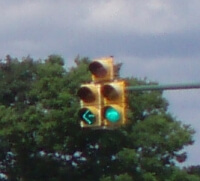
Why are there turn arrows at some signals and not at others?
Turn arrows give the right-of-way to those in the turn lane by adding delay to other movements in the intersection. Each time there is a new phase, with an arrow or a green ball (regular green light), it adds some inefficiency to the intersection by needing time to change to the next phase where no one should be moving for safety reasons. In traffic engineering lingo that is called “lost time.” It occurs at the start of the movement where drivers are slow to react to the start of the green, at the end of the green where vehicles are less densely packed, and during the all-red when no one should enter in the intersection. In order to offset the lost time, cycle lengths have to increase. The cycle length is time from when the green starts to the time that the next green starts for the same movement. Longer cycle lengths add vehicle handling capacity to the intersection while shorter cycle lengths reduce delay assuming that the cycle lengths are just long enough. See our traffic signal article for more information.

Why do I have to wait so long for a green light on a side street?
This is one of the big disadvantages of a signal. Coordinating signals requires that the signals all have the same cycle length. While a short cycle length at one intersection would be efficient and have short delays for the side street, a nearby signal may need a long cycle length forcing the rest to also have long cycle lengths. The coordination of the signals, which benefits the main street, gives all excess time that the other movements (side streets or turn lanes) don’t need to the main street through movements. This excess time benefits the main street, but is why the side street wait is so long. See our traffic signal article for more information.
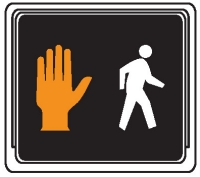
Why is the WALK light so short, and the flashing DON'T WALK light so long?
The WALK is usually short, 4 – 7 seconds. It is intended as a time for people to enter the street. The flashing DON’T WALK means finish crossing, but don’t start if you are on the sidewalk. The flashing DON’T WALK sometimes will have a countdown timer showing how much time is left to finish crossing the street. The timing of the flashing DON’T WALK is based on a slow walking speed of 3.5 feet per second for the very young, elderly and handicapped, so most people have more than enough time to cross. In the case of a pretimed and some semi-actuated signals, the WALK signal may be longer since the green time is longer than the flashing DON’T WALK plus 7 seconds. In most cases with actuated signals where there are pedestrian signals, the DON’T WALK alone is longer than the vehicular minimum green times, so a longer WALK would only make a longer green for an approach that does not need it, and thereby delay everyone else, including a pedestrian wanting to cross in a different direction. See our traffic signal article for more information.
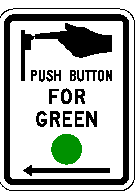
Do I really need to push the pedestrian button?
Yes. The pedestrian button is there not only to call up the pedestrian indication that may display during a parallel vehicle movement, but it also causes the green to be longer since the cars may need less time than a pedestrian. For example, with a five lane main street and only two cars waiting on the side street, the signal may only give five seconds of green to the side street for the cars, but the pedestrian crossing the main street would need 15 - 20 seconds to walk to the far side of the main street plus time for the WALK display. Some newer pedestrian buttons have a confirmation light showing that signal controller received the call. Pushing the button more will not make the walk signal come up faster. See our traffic signal article for more information.
Is driving while talking on the phone with a hands free headset safe?
The first thing we need to do is define “safe.” There is risk in everything so here we will assume “safe” is normal driving without talking on the phone. In that case, no. The driver’s hands aren’t the problem. It is the driver’s mind that is doing another task. Human beings don’t multitask at a high level! They switch back and forth between tasks. The problem is that sometimes they forget to switch back to driving instead of thinking about the discussion. It is worse than talking to a passenger because the passenger is also looking at dangers coming up, while the person on the other end of the phone call can’t assist the driver, or simply know when to stop talking. Of course, texting or checking email is much worse since the eyes and mind are off the road for longer periods of time.
How often should traffic counts be taken?
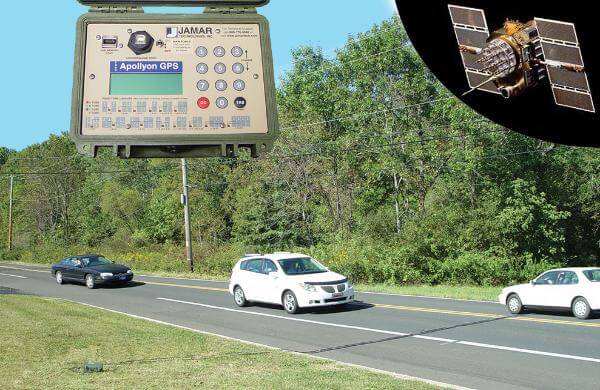 It depends on the purpose of the counts. Some communites and state DOTS try to count every major road every three years. These are typically what are called hose counts that count vehicles along a roadway segment. Turning movement counts at intersections are collected more on an as needed basis due to their cost and effort involved. See our traffic survey article for more information.
It depends on the purpose of the counts. Some communites and state DOTS try to count every major road every three years. These are typically what are called hose counts that count vehicles along a roadway segment. Turning movement counts at intersections are collected more on an as needed basis due to their cost and effort involved. See our traffic survey article for more information.
Didn’t see your question? Shoot us an email and we will add it to our FAQ page.
